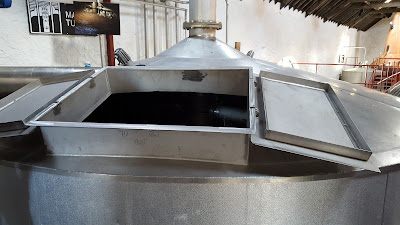Immediately after the Springbank tour, Mitch the Guide took us on a five minute walking tour to Glengyle distillery, through a graveyard of a half dozen fallen warehouses. We were on the grounds where at least two dozen distilleries stored spirit during a previous scotch whisky boom. Two dozen dead distilleries. At Campbeltown's peak, that long row (*cough*) of dunnages was among the most valuable square miles in the UK outside of London. But stone and green overgrowth (albeit quite lovely) is all that remains. That and Springbank.
And Glengyle.
Just after the turn of the millennium the Scotch Whisky Association announced that any whisky region with fewer than three distilleries would lose its designation. Clearly the SWA has nothing better to do. At the time Campbeltown had two distilleries, Springbank and Glen Scotia, so its designation was endangered. To remedy this, Springbank's owners (J&A Mitchell) bought the defunct-since-1925 Glengyle distillery and announced they would spruce it up and start production.
Former Master Distiller Frank McHardy was tasked with Glengyle's restoration.
Beginning production in 2004, they began releasing "Work In Progress" bottlings in 2009, ultimately leading to a 12 year old this year. The quality of the WIP single malts range anywhere from very good to fabulous. Some of the best single malt in Scotland is being made there, but it's not sold as "Glengyle". The rights to that name are owned by Loch Lomond DCL, as they used to produce a Glen Gyle blend. During the tour, I was told that Mitchell & Co offered to buy the rights to the name but were quoted a laughable price. (I'm inclined to believe that story since Loch Lomond is possibly the oddest whisky company in Scotland.) The owners instead went with Kilkerran since it was the name of the original religious settlement in the area, the Church of Saint Kerran.
Glengyle's revival was partially successful due to luck. The long extinct Ben Wyvis distillery's stills were available and were functional after some service. At the same time, Craigellachie was in the process of disposing of its old small mill so Glengyle swooped in and picked it up.
Unlike the spread out nature of Springbank's distillery, Glengyle's production happens all in one place. So the mill, mash tun, washbacks, and stills are all in one relatively small room, making it feel like a little more artisan (yes, I know that word is now meaningless) than most scotch whisky factories.
Above, Mitch demonstrates a piece of somewhat computerized machinery. Yes, this is space age stuff for the Springbank folks. And it certainly appears Space Age, as in from the 1960s.
Unlike Springbank, Glengyle does use a closed mash tun, another somewhat modern choice. Also unlike Springbank's mash, which takes four water runs, Glengyle uses three waters.
The distillery is in production for only six weeks a year, which has actually caused warping issues with the washbacks during the long rest periods. There are four 30-litre washbacks in total. While we were there, one washback was off-limits and empty because the wood needed to be replaced. That leaves three washbacks...
Midway through our tour we were standing near the top of one of the functioning washbacks when from beneath us we heard a crack crack WHAM! SPLASH! drip drip drip drip drip.
By the look on Mitch's face, I'm just going to guess that leaves them with two washbacks. Sounds like the plot to a Scottish children's book, The Four Little Washbacks.
 |
| Four little washbacks were fermenting one day Over in Kintyre, far away |
The angle of the lyne arm incline is greater than that of Springbank's, creating a lighter spirit.
Since I forgot to include photos of a Springbank dunnage, here are a couple photos of Kilkerran stuff.
You see those four huge port pipes above? Yes, those are the wombs of Kilkerrans to be. Don't you just want to pop the bung out and take a taste? Well, I didn't. But. But. But, I can't tell you anymore until the next post about the next tour.

















